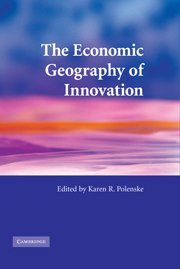Book contents
- Frontmatter
- Contents
- List of figures
- List of tables
- Notes on contributors
- Acknowledgments
- Abstracts
- List of abbreviations and acronyms
- Part I Concepts and measurements in innovation
- Part II Institutional and spatial aspects of information and knowledge flows
- Part III Institutions and innovation systems
- 10 National systems of production, innovation, and competence building
- 11 Perspectives on entrepreneurship and cluster formation: biotechnology in the US Capitol region
- 12 Facilitating enterprising places: the role of intermediaries in the United States and United Kingdom
- 13 Innovation, integration, and technology upgrading in contemporary Chinese industry
- 14 Society, community, and development: a tale of two regions
- Index
- References
12 - Facilitating enterprising places: the role of intermediaries in the United States and United Kingdom
Published online by Cambridge University Press: 22 September 2009
- Frontmatter
- Contents
- List of figures
- List of tables
- Notes on contributors
- Acknowledgments
- Abstracts
- List of abbreviations and acronyms
- Part I Concepts and measurements in innovation
- Part II Institutional and spatial aspects of information and knowledge flows
- Part III Institutions and innovation systems
- 10 National systems of production, innovation, and competence building
- 11 Perspectives on entrepreneurship and cluster formation: biotechnology in the US Capitol region
- 12 Facilitating enterprising places: the role of intermediaries in the United States and United Kingdom
- 13 Innovation, integration, and technology upgrading in contemporary Chinese industry
- 14 Society, community, and development: a tale of two regions
- Index
- References
Summary
Introduction
Many communities around the world want the economic benefits associated with high-technology jobs and companies. But creating and nurturing centers of high-technology, what we call “enterprising places,” is a complex business. Even when a place has the essential resources: an excellent university or research center, land and facilities for companies, and an educated workforce, it is not clear how to sustain a center from them. The efforts of policymakers to do just that comprise a rich source of experimental evidence. In 2002 and 2003, a research team from MIT and the University of Cambridge set out to examine this evidence in five regions known to be centers of high-technology in the United States and United Kingdom.
To guide the research, we focused on four realms that figured prominently in enterprising places: knowledge, finance, policy, and place (figure 12.1). We were especially interested in actions at the intersections of these realms and how they enhanced a location's competitiveness. We defined the “knowledge realm” to include the people, skills and ideas, and related education and research institutions that were located in a particular place. The finance realm represented the capital, institutions, and people that sustain investment in a place over time. The “policy realm” represented the institutional and regulatory context and the public and private policy agents that influenced the development of a place. The “place realm” represented the competencies of the location in terms of proximity, access, and concentration.
- Type
- Chapter
- Information
- The Economic Geography of Innovation , pp. 261 - 288Publisher: Cambridge University PressPrint publication year: 2007
References
- 1
- Cited by



